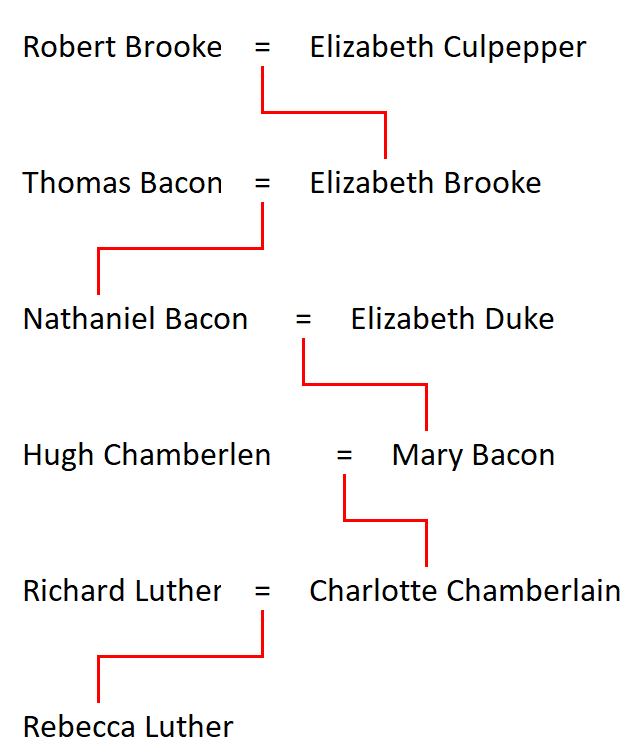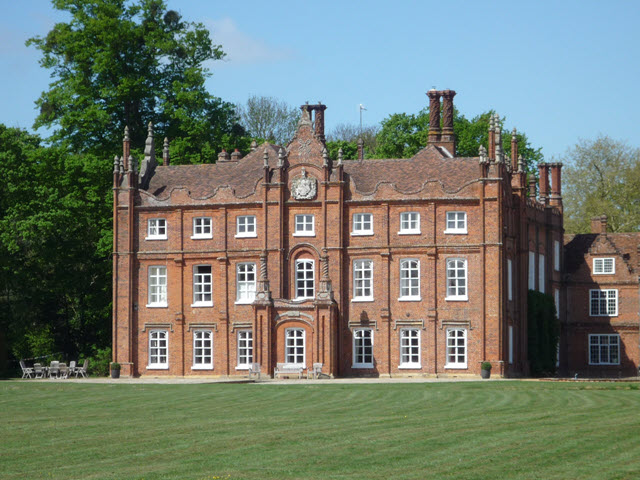Elizabeth (nee Colepeper) Brooke, Writer (Born 1601)
10th Great Grandmother – FFFMFFMMMFMM1
Elizabeth Brooke (nee Colepeper) was the maternal grandmother of Nathaniel Bacon, and therefore my 10th great grandmother. She was a famous religious writer.

Elizabeth Brooke was born Elizabeth Culpepper2 at Great Wigsell in the parish of Salehurst in East Sussex in 1601, the only daughter of Thomas Colepeper, by his first wife Anne Slaney. Thomas was MP for Winchelsea and Rye during the latter years of the reign of Elizabeth I3.
In 1620 Elizabeth married Sir Robert Brooke, son of a prominent London Alderman. Robert had been educated at Emmanuel College, Cambridge and at Gray’s Inn. Elizabeth was Robert’s second wife, his first wife Joan Weld having died in 1618. Elizabeth’s aunt Dame Mary Weld was Joan’s step-mother.
While Robert and Joan had been childless, Robert and Elizabeth had three sons and 4 daughters. Elizabeth the second daughter was born in 1622 and married Thomas Bacon of Friston Hall in Suffolk and was the mother of Nathaniel Bacon.

Robert’s father, also Robert, had purchased Cockfield Hall in Yoxford, Suffolk, and this is where the family settled and where most of the children were born. Through the 1620s, Robert represented the parliamentary borough of Dunwich in Suffolk.
Elizabeth’s brother John Colepeper was also an MP, being very active during the lead up to the English Civil War. He represented Rye in 1640 and was elected for Kent in the Long Parliament4. in 1642 he was appointed as Chancellor of the Exchequer.

He was a member of the Royalist party during the Civil War and after the King’s final defeat in 1646 he spent the next 15 years abroad.
Sir Robert Brooke meanwhile died aged 74 on 10 July 1646 and was buried in Yoxford church. Elizabeth lived another 35 years, and after a long illness she died at Cockfield Hall on 22 July 1683.
Elizabeth’s chaplain, Nathaniel Parkhurst was the vicar of Yoxford where he was buried, and in the year after her death he published his funeral sermon along with a an account of her life and death and her writings entitled “Observations, Experiences and Rules for Practice”, which he stated he had “found written with her Ladyship’s own Hand”5.
In addition to this manuscript, Parkhurst refers to a “great number of writings in her own hand”, including “Body of Divinity” written in 1631 and collections of Commentaries upon Holy Scriptures, and the “Sum of the Controversies between Us and the Papists”.
References
“DAWTREY, William (d.1591), of More House, Petworth, Suss.” 1964-2020. The History of Parliament Trust. 1964-2020. https://www.historyofparliamentonline.org/volume/1558-1603/member/dawtrey-william-1591.
“Long Parliament.” 2025. Wikipedia; Wikimedia Foundation. 2025. https://en.wikipedia.org/w/index.php?title=Long_Parliament&oldid=1280640140.
Parkhurst, Nathaniel. 1684. The Faithful and Diligent Christian Described and Exemplified. London: Samuel Sprint; John Harding. https://quod.lib.umich.edu/e/eebo2/A56406.0001.001.
Footnotes
-
When showing relationships F means Father, M means Mother, U means Uncle and A means Aunt. So FFM is my father’s father’s mother, and FFMU is my father’s father’s mother’s uncle.↩
-
In the early 17th century the name Culpepper was often written Culpeper or Colepeper.↩
-
(see “DAWTREY, William (d.1591), of More House, Petworth, Suss.” 1964-2020).↩
-
The Long Parliament was the name given to the Parliament from 1640 to 1660, (see “Long Parliament” 2025)↩
-
(see Parkhurst 1684)↩